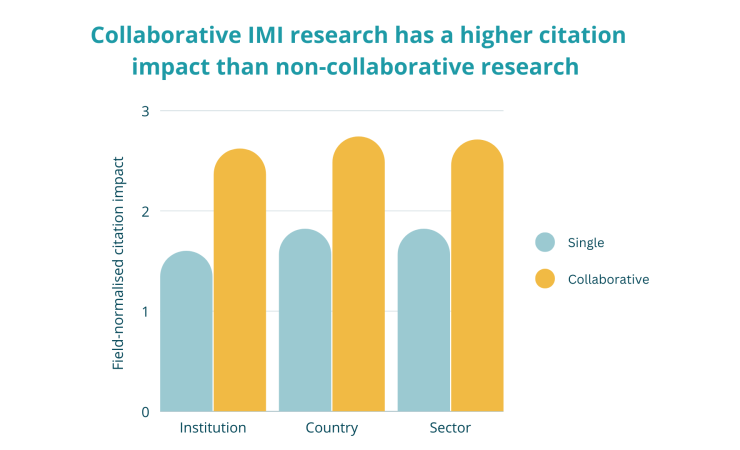Scientific journals are an important route for Innovative Medicines Initiative (IMI) projects to share their results with the wider health and scientific communities. For this reason, the IMI (now IHI) Programme Office started analysing the publications produced by IMI projects early on in the programme. The analysis is carried out by Clarivate and the results are published annually in a report. The latest report, which covers papers published from the beginning of IMI to the end of 2021, has just been published.
The number of publications is stable at a high level
By the end of 2021, IMI projects had published a total of 8 609 papers. Since 2018, the number of new papers published annually has stabilised at around 1 000. According to the report, this stabilisation is to be expected and reflects the maturity of the IMI programme; the output of older projects that have closed has started to fall, while the output of newer projects is gradually rising.
As the report notes, it can take months for a new project to generate enough data to put together its first publications, and the most significant results may take years to emerge. As some IMI projects are still relatively young, their impact in terms of publications is likely to grow significantly in the years to come. In fact, the publication output of most IMI2 calls is currently growing.
IMI project papers are making waves
The report also explores the citation impact of IMI project papers; this is basically a count of how many other papers cite a paper, compared to other similar papers published in that field and year.
According to the latest report, the field-normalised citation impact of IMI project papers stands at 2.03. This is twice the world average (for which the baseline is 1) and considerably higher than the EU’s average citation impact in similar biomedical fields, which is 1.15.
Furthermore, a quarter (25.3%) of IMI papers were in the world’s top 10% of most highly cited papers in the relevant field and year of publication, suggesting very strong performance
IMI’s performance on both measures compares well with other similar research-funding organisations such as the Wellcome Trust, the Commonwealth Scientific and Industrial Research Organisation (CSIRO), the Critical Path (C-Path) Institute, and the Foundation for the National Institutes of Health (FNIH).
IMI research is collaborative (and collaborative research has a greater impact)
Another element addressed by the report is the collaborative nature of IMI project research. Put simply, IMI project research is collaborative across institutions, sectors, and countries. Furthermore, collaborative papers have a higher citation impact than non-collaborative papers.
A majority (86%) of IMI project papers involved collaboration between different institutions, and the citation impact of papers involving authors from different institutions is 2.62, compared to 1.60 for single-institution papers.
Nearly two-thirds (65%) of all IMI project papers were internationally collaborative, and these papers, featuring authors from more than one country, had a citation impact of 2.74, compared to 1.82 for papers with authors from just one country.
Finally the report looks at papers with authors from more than one sector. In this analysis, the term ‘sector’ refers to the authors’ organisation types, which are categorised as medical, corporate, academic, government, other, and unknown. The report reveals that some two-thirds (67%) of papers were co-authored by researchers from different sectors, and papers with cross-sector authorship had a citation impact of 2.71, compared to 1.82 for papers with authors from a single sector.
‘As this report shows, IMI projects are continually generating and sharing new knowledge on a huge range of disease and health issues,’ said IHI interim Executive Director, Dr Hugh Laverty. ‘Furthermore, the strong performance of collaborative papers shows the added value of the international public-private partnership approach pioneered by IMI.’
The Innovative Medicines Initiative was a partnership between the European Union and the European pharmaceutical industry.
